Revolabs FLX Review
Revolabs may be one of those companies you've never heard of, but if you've used the audio system in your companies boardroom, your local church, a trade show or similar event, you may very well have used their equipment without even realising it. The Revolabs FLX is a new product, that opens their products up to a larger audience which includes SMB all the way through to enterprise size businesses. Revolabs had heard that Epilio do a lot of work enabling Sametime with telephony systems, so sent us the Revolabs FLX2 to review. Video review located at bottom of article.
The device comes in a environmentally friendly recycled cardboard box, and upon opening it, you are immediately presented with the instructions sheet for connecting the device.
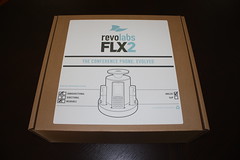
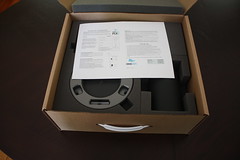
After removing the instruction sheet, you're can see the core components for the package, the wireless handset, the wireless speaker, the charger station and the wireless microphones.
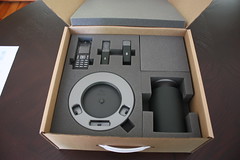
The bottom layer contains the base station which connects to the phone, bluetooth and audio sources and two power supplies and a phone cable.
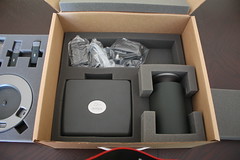
The next step is to connect everything up. The wireless microphones, handset and speaker sit in the charger station, which is connected to the power and the base station is connected to a power supply and your PC/audio system, bluetooth device and telephone system (see video for connections).
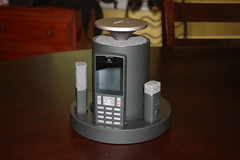
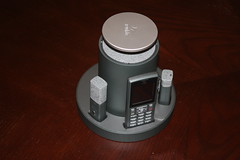
The unique thing about the Revolabs FLX setup, is that the speaker and microphones are all wireless. What this means is that you can give a microphone to someone at one end of the table, and a microphone to someone at the other, and put the wireless speaker in the middle or anywhere else you want. This avoids the situation I often hear or see, which is a speakerphone that has been placed right beside the projector with the cooling fan blowing on it during the entire conference call, leading to a pretty miserable experience for the person attending the call on the phone. In the review system I was provided with, I had a table top microphone and lavalier/lapel microphone.
Here you can see the speaker removed from the charging station
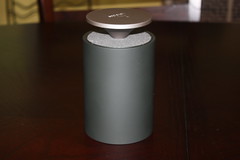
The base station that does all the work,
can be placed on a shelf somewhere or in a cupboard, it can connect to
your telephone line, a Bluetooth device and a device that has audio input
and output. In my case, I connected the device with my regular telephone
land line, my Bluetooth phone (iphone) and connected it to my PC
for use with IBM Sametime,
Microsoft Lync and Skype.
Connecting it to your phone line is
a just a case of plugging in the supplied phone cable, and connecting it
to your phone jack. When it's connected, the handset immediately
shows the phone line as being there, and you can now make and receive calls
using the handset. Audio quality as you'd expect from a high end
audio company was very good. The handset has an easy to read screen,
provides a list of missed or recently made calls, has a directory for storing
phone numbers and options to configure various settings. Sometimes
for my big fat fingers the buttons felt a little small, but they always
worked, and I got what I expected when I pressed them, so there wasn't
really a problem.
Bluetooth pairing was simple using the
handsets menu system. Unfortunately, you can only receive calls,
or join existing calls using bluetooth, you cannot use the handset as a
dialer for your Bluetooth device, so if you want to join the call using
your Bluetooth phone, you have to dial the call using the phones keypad,
not the Revolabs FLX handset. In most cases this won't be a big issue,
in the future as more companies move towards replacing desk phones with
mobile phones, this might be a missed feature. That time is a long
way off though, and I'm sure Revolabs could address that if it became a
big demand.
Connecting to my PC proved a little
difficult, and it turned out to be an issue with my laptops audio system.
If I connect a mono 3.5mm cable to my microphone socket on my laptop
it turns out, my laptop won't record audio from it, the cable has to be
a stereo cable. The sockets on the Revolabs base station are mono,
so I was going mono to mono. Using a mono to stereo converter cable solved
my issue. My desktop PC didn't experience this issue, and it turns
out it really depends on the chipset in the machine, or driver, as there
were even differences between similar PCs, but made at a different time.
Once I had connected the device to my PC, I tried it on IBM Sametime,
IBM Sametime with SUT, Microsoft Lync and Skype audio calls. The
quality, as with Bluetooth and the phone line was excellent, with the PC
audio it is even clearer than the phone line due to the much higher quality
codecs used over the ancient phone system. The device doesn't have
any specific plugins for Sametime or Lync, like some of the Plantronics
devices for example so is purely interfacing with the PC as a MIC and Speaker,
so this means if you mute the device on the PC that isn't reflected in
the handset and vice verse. There is currently a USB socket on the
base station and charger station, but this does not interface with the
PC, in the future it would be great if that could be used as the audio
connection, and also to provide a method for updating the handsets address
book from the PC.
One thing that is really nice about
the Revolabs FLX2, is the ability to merge audio streams, what does this
mean? Imagine you're on a Sametime phone call, using the PC audio
connected to the Revolabs device, and the telephone rings, well now you
can answer the phone and the Sametime calls audio and Phone calls audio
are now merged, so you can continue to hear and speak to the Sametime person,
and telephone connected person, but more importantly, the Sametime folks
and telephone folks can also hear and chat to each other. The mixing
levels between the line scan be controlled by a menu on the wireless handset.
One thing the Revolabs has going for
it, is certainly it's looks. Everyone that has come by and seen it
sitting on the table have always asked "Sweet, where's mine?"
If you're a company that has spent a small fortune on your conference
room table, this thing is not going to look out of place if it's made from
glass and metal or is 200 year old antique mahogany. It's a really
nice, classy looking device.
Overall I was very impressed with the
device. It's has an attractive unique design, offers great audio
quality which is really what matters and a number of connection options.
Pros
Audio Quality
Appearance and Build Quality
Connection options
Audio Bridging
Cons
Not able to initiate a Bluetooth call
using the devices handset
Cannot yet connect to a PC using the
USB sockets, so no way to update the directory from your PC
Price: MSRP $999
Website: http://www.revolabs.com
Location: Sudbury, MA USA
Phone: 978-610-4040
Competition: Polycom, Konftel,
ClearOne
Whilst it's not easy to demonstrate
a speaker phone system on video, I've attempted to do just that with this
video review.

Comments
Posted by null At 04:38:17 PM On 09/27/2011 | - Website - |
Posted by Leonard Balk At 07:03:55 AM On 10/28/2012 | - Website - |
Great piece. I am considering using this unit in a mid sized conference room. A basic question I had when looking into this was can I add more Mic's? Do the bluetooth devices added to the call actually act as microphones? Could you add any bluetooth microphone for that matter? I was shocked that between web searches and installation manuals, I can't seem to find these details.
Thanks for the review.
Posted by Chris Bailey At 09:43:22 PM On 01/14/2013 | - Website - |
Posted by Roger Howerton At 10:17:36 PM On 12/15/2016 | - Website - |